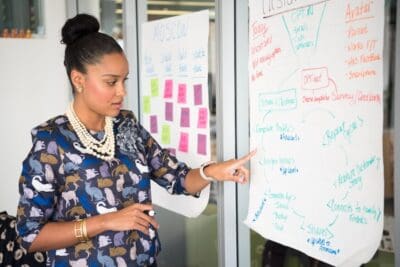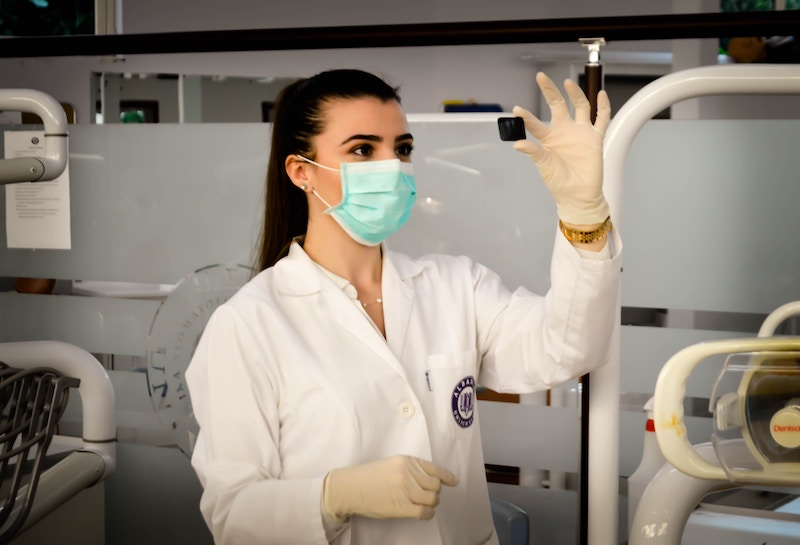
Accelerating CTE
JFF powers up career and technical education to help more adults with limited academic skills earn credentials that lead to good jobs. JFF powers up career and technical education to help more adults with limited…

May 14, 2019
At JFF, we and our partners are proud of the student successes achieved through career pathways, but more needs to be done. We see three opportunities for boosting their impact.
Pathways area critical resource for adult learners seeking family-supporting careers.
In Texas, integrated pathways helped 29-year-old Lacey earn her GED plus a welding credential. In Kansas, William earned his GED and found his professional calling in the aerospace industry. In Kentucky, the high level of support provided through her health care pathway helped propel Erin, a single mother, toward a registered nursing degree. And at the colleges participating in JFF’s Accelerating CTE initiative, integrated pathways helped more students earn multiple stackable credentials in high-demand fields.
These success stories demonstrate the impact that pathways have on individuals and their families. Yet for every success story, there are thousands more people who could benefit from a pathways program, the structured system of education and employment opportunities that Lacey, William, and Erin participated in.
These opportunities are increasingly important in light of recent trends, including growing economic insecurity, an increase in low-wage jobs, and declining social mobility. Meanwhile, the jobs that do open doors to upward mobility require specialized skills and postsecondary credentials. This is why JFF is committed to scaling programs that increase access to high-wage, high-demand careers.
To truly achieve scale, we need to change—not just the instruction or the curriculum, but the whole structure of community college.
At JFF, we are proud of what has been accomplished through initiatives like Accelerating Opportunity, TAACCCT, and the Accelerating CTE initiative supported by the ECMC Foundation, and we celebrate the success of the thousands of students who have earned postsecondary credentials. But we have not yet reached scale, and we are not satisfied with the number of success stories we have now.
To truly achieve scale, we need to change—not just the instruction or the curriculum, but the whole structure of community college. This includes student recruitment and onboarding, funding, and how data is collected and analyzed. Most importantly, we need to focus on how we invest in success for all students.
To achieve more equitable economic advancement, community colleges must ensure that institutional transformation benefits all students—including those who enter in nontraditional ways, such as adult education, workforce training, and noncredit programs. All organizations—nonprofits, intermediaries, funders, colleges, and postsecondary systems—that want to have an impact on equity and economic mobility must determine where we should invest our time, effort, and money. As we reflect on what JFF has learned across multiple pathway initiatives, we see three opportunities for impact.

As enrollment of traditional-age students declines, colleges must identify opportunities to enroll more adult students—in particular, students from underrepresented and historically underserved populations. This focus on adult learners is critical for colleges’ long-term viability, but also from an equity perspective. To address longstanding degree-attainment gaps and promote economic mobility for all, colleges must be much more intentional about recruiting and supporting diverse students. This means meeting potential learners wherever they are—including partnering with the workforce system, employers, community-based programs, and even local churches.
Unless there are adequate on-ramps to postsecondary pathways, some learners will inevitably be left behind. Colleges need to ensure that all entry points have the potential to lead to credit-bearing courses and even college transfer. For many adult learners, the first experience with a community college is through adult education, English as a second language courses, noncredit workforce programs, and short-term training. These students may not necessarily see themselves as college-ready, but they are the students who need access to opportunities and stand to benefit the most from comprehensive pathways.
All too often, concerns about cost prevent colleges from investing in innovative and promising practices. While there are many legitimate concerns about inadequatefunding for community colleges, the perceived cost of an intervention often holds us back. Our experience with integrated education and training models like Accelerating Opportunity is a great example.
Colleges assume there could be no way to sustain a model that requires two instructors in one class. But evaluations of Washington State’s I-BEST model show that participants go on to earn more credits than nonparticipants—and those additional credits generate tuition revenue. Yes, the model has added costs, but many of those costs can be recouped over time.
Colleges must make a culture shift around how resources and costs are understood. For example, when building pathways for students who start in adult education, the question must shift from “How much do we have in our adult education budget?” to “How does investing in adult education affect college revenue once those students transition to college coursework?” Instead of just asking how much a new program or initiative costs, colleges can start asking how the new program will increase the number of students who stay in school, and whether the tuition dollars associated with increased retention will cover the cost of the program.
The best-designed pathways are only effective if students move through them as intended. Yet, most colleges are not in the habit of examining the trajectories of students who enter career pathways, especially those who start in an integrated Adult Basic Education pathway. We don’t know, for example, how many welding students continue past the first semester, whether they stay in the welding pathway, and whether they earn additional stackable credentials along the pathway.
The challenge is that student data systems are not built with this type of analysis in mind. As we learned through AO CTE, there were no ready-to-run queries that looked at what happened to a cohort of welding students. Instructors and department chairs often know anecdotally what happens to their students but don’t have historical data to look at. In many colleges—and especially smaller colleges—limited institutional research capacity makes it hard to find time to design the custom analyses needed to really dig into pathways data.
To improve pathway designs and target interventions effectively, colleges need to start asking questions like “What courses in the pathway are most predictive of successful completion?” and “Can course sequences be adjusted to better accommodate part-time students?” With the right data and the right questions, colleges can understand if pathways are truly serving students’ needs.

Success stories, like those of Lacey, William, and Erin, help us understand the real-life impact of our work, but at JFF, we want success to be the norm for all learners. Bringing pathways to scale means ensuring that robust pathways are available for all students, no matter where they start their educational journeys and no matter what their career goals are.
Over the past decade, we have learned a lot about evidence-based and data-informed practices that community colleges can use to support students from entry to employment. Now we need to ensure that colleges have the appropriate pathways infrastructure that will help students climb the ladder to economic success.

JFF powers up career and technical education to help more adults with limited academic skills earn credentials that lead to good jobs. JFF powers up career and technical education to help more adults with limited…

This series summarizes the Accelerating CTE project at four of the participating colleges. It provides details on student outcomes and the college’s lessons learned, and recommendations for further inquiry to improve student success and meet…

Community colleges and non-traditional student populations, such as adult learners, often experience a unique set of academic and non-academic challenges. This is particularly true for those in rural America, where resources and community supports are…